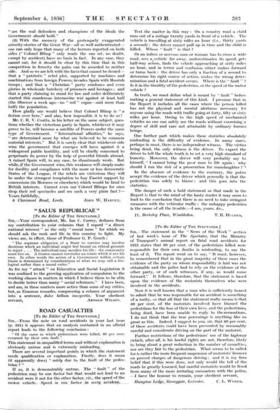ROAD CASUALTIES
[To the Editor of Tau SPECTATOR.] SIR,—From the note on road accidents in your _ last issue (p. 831) it appears that an analysis contained in an official report leads to the following conclusion : ;
" Of the cases in which pedestrians were killed, 80 per cent- occurred by their own. fault.
This statement in unqualified terms and without explanation is obviously untrue and is extremely misleading.
There are several important points in which the, statement needs qualification or explanation. Firstly, does it mean (it apparently does) " solely ,due to the, fault of ,the pedes-.
trian ? -
If so, it is demonstrably untrue. The `` fault." of the pedestrian may be one factor but that-would not lead to an accident were it not ter-the,other: factor, ;viz.,.the speed of the motor- vehicle. • • Speed oriy: ,faetor„in _et7ery, accident.... Test the., in this way : On a .country road a child
runs out of a cottage twenty yards in front of a vehicle. The vehicle is travelling at sixty miles an hour (i.e., thirty yards a.second) : the driver cannot pull up in time and the child is killed. Whose " fault " is that ?
Or an infirm or nervous man or woman has to cross a wide road, sees a vehicle far away, underestimates its speed, gets half-way across, finds the vehicle approaching at sixty miles an hour, and in terror and confusion either rushes forward or turns back : the driver has only a fraction of a second to determine his right course of action, makes the wrong deter- mination and a fatal accident occurs. Where is the " fault " ? Is it in the timidity of the pedestrian, or the speed of the motor vehicle ?
In truth, we must define what is meant by " fault " before making a general statement of this kind. I presume that in the Report it includes all the cases where the person killed has not the physical and mental alertness necessary for anyone using the roads with traffic going at forty, fifty or sixty miles per hour. Owing to the high speed of mechanical vehicles no one can safely use the roads without exercising a degree of skill and care not attainable by ordinary human beings-
One further part which makes these statistics absolutely misleading is the difficulty of evidence. In many cases, perhaps in most, there is no independent witness. The victim being dead, the only witness is the driver. To expect the driver to tell the whole truth is to set a very high standard of honesty. Moreover, the driver will very probably say to himself, " I cannot bring the poor man to life again : why should I run the risk of a prosecution for manslaughter ?
In the absence of evidence to the contrary, the police accept the evidence of the driver which generally is that the pedestrian was solely to blame : and this goes into the statistics.
The danger of such a bald statement as that made in the Report is that to the mind of the hasty reader it may seem to lead to the conclusion that there is no need to take stringent measures with the vehicular traffic : the unhappy pedestrian is the cause of all the trouble.—I am, yours, &c., 11, Berkeley Place, Wimbledon. T. R. HUGHES.






































 Previous page
Previous page